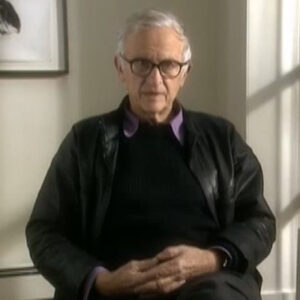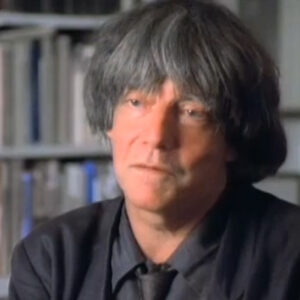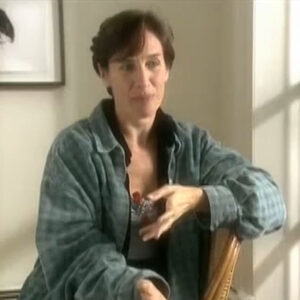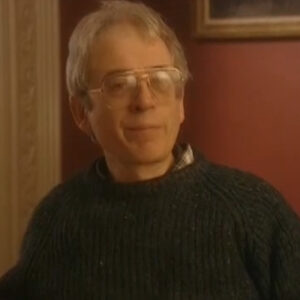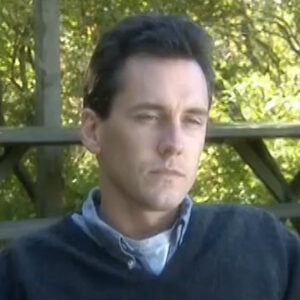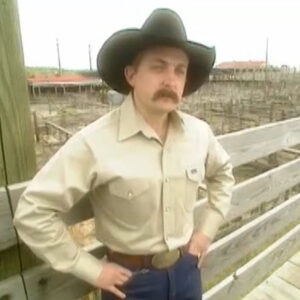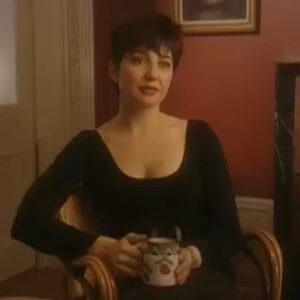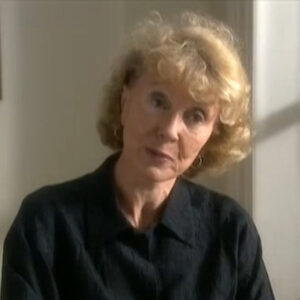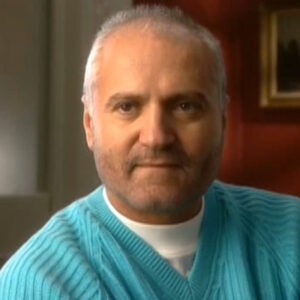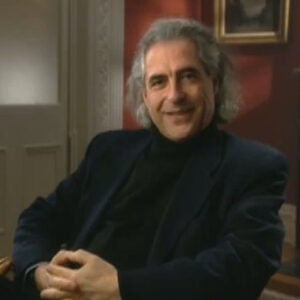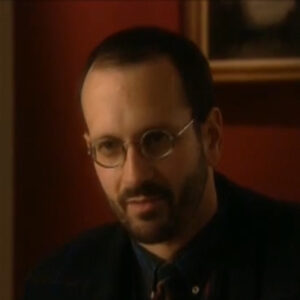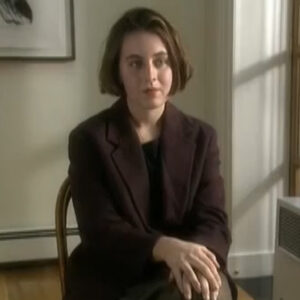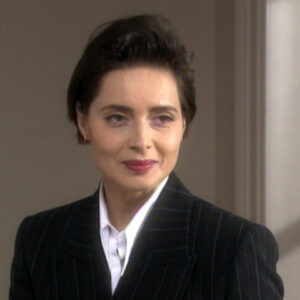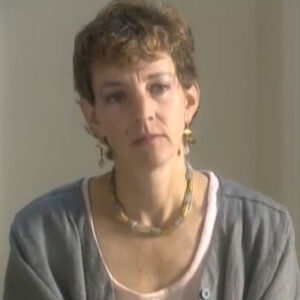Speaker When I first worked for Dick, oh, he had borrowed the clothes from Bergdorf Goodman and by telling them that I was booked for him. They let him the clothes. And all the time I was posing. He was saying, oh, you’re a famous model. You’re a famous model. And I wasn’t really in those days, you didn’t know the models name like you do today? Well, he convinced me I was a famous model and I worked with him mostly on advertising until the first time that I went to Paris with him. That was the first editorial work I’d done with him. And I was so excited, of course, to be going to Paris. Dick was only secondary. It was Paris. That was the marvelous incentive. And when we got to Paris, the other model and me, it was at early, which was a much smaller than present than Charles de Gaulle. And he was standing at the door. I don’t know how he got permission, but he was standing at the door of the building with his arms full of flowers.
Speaker And he had brought along the an old old taxi. One of the kind that, you know, in during the First World War was rescuing soldiers.
Speaker And there was an old fashioned chauffeur standing beside him and it had an open roof all the way to Paris. It was it’s a long way from Paris itself, but all the way he was pouring champagne into glasses and Joe Eulo was slicing peaches into the glass. It was so exciting. I stood up through the hole in the roof and saw the Arc de Triomphe. The most exciting moment of my life. It did change my life because after that, of course, I went back to live in Paris, where I lived for 22 years. But when we got to the hotel, that was the most exciting part. Two of the rooms that we had. It wasn’t a room, it was a suite, but little downstairs parlor and up the stairway. It was the bedroom and the door opened right off the lobby. It was covered with mirrors who didn’t even know that it was a room. And the bathtub was downstairs off of the little living room. It was filled with flowers floating on the water. And then he said, Girls, you don’t have time to do anything. We’re going to have lunch. And we went to some clue. I think it was. Yes, thank you. And had lunch on a boat as if Paris already wasn’t exciting enough. That was the end. And the food. I remember the day. The food. Exactly. It was enchanting and it was just a roast chicken, but it tasted like no other chicken I’d ever eaten.
Speaker What does that do to restore trust?
Speaker Well, with his moves into this of.
Speaker It was yes, it was that that was the marvelous thing, is it was as though he was setting a scene for a movie. And we were just fit it into this beautiful picture that he had already arranged in his head. And that’s what was wonderful about it, was that every scene we did in Paris was, in his mind, a typical little Parisian scene.
Speaker And we posed in front of flower boxes. We went to a little circus. We went to a convent and posed with children. And he photographed us with baby carriages.
Speaker Everything was a scene in his head from his movie called Paris.
Speaker The wonderful thing about him photographing. Of course, I didn’t realize in those days the difference between his method because it was so completely new. And other photographers that I’d worked with a great deal like Irving Penn, they both wanted control, complete control.
Speaker But the difference was that Dick participated. He almost was the model in his head.
Speaker He was doing all of the things. And we were fortunate because we understood each other so well that I’m sure I did every scene just the way he’d pictured it without his ever saying a word, except wonderful, wonderful, wonderful.
Speaker It was specifically what a what it seems like and what the city. Right.
Speaker Well, the settings with Penn were also arranged in his head. But he gave you no background. You just stood in a corner or sat on something and his lights were completely fixed.
Speaker They were white, the whitest white you’ve ever seen. And he was using silk screens to put the light through, which made a marvelous air and a marvelous spirit, but knows no objects. And he would take all those scenes that I did with him where at in forty nine, which were supposed to be different periods, up to the half of the 20th century.
Speaker He took sometimes 150 shots. Because then he would pick the one thing and you’d sit there doing the same thing over and over and over again until in his mind he’d gotten the picture. Whereas deep he moved around. And you it was part. He was, as I said, participating. He was there in front of the camera himself. He took part in it, whereas Penn separated himself. And you became a still life object.
Speaker Describe how it prepared you for the sorts of famous cyclist shop.
Speaker Well, among the scenes that he had set up in his mind was the Tour de France, which is a bicycle race. I’d never heard of such a thing. And he photographed me in the midst of the crowd of the cyclists when they had just finished. And, of course, they were perspiring. I was going to say sweating, but perspiring and hot. And yet they understood that he wanted this Parisian scene, me dressed in Christian Dior, kissing this grimy little cyclist.
Speaker And I must say. And in the middle of it, he said, well, I was laughing and kissing him. Don’t mind about your teeth. That doesn’t matter because I had a on a tooth.
Speaker But as I said, he participated fully. He saw that spot on my tooth and he didn’t care. It was part of the scene. Why a rich lady in a Christian Dior would have his partner, too. I don’t know. But it added reality. And that was what he was looking for.
Speaker Poetic reality and also the life of the show, which I was sitting in the backseat of a hispanos reason, the only time I ever saw one in my life.
Speaker I think I don’t know where he found it. And.
Speaker He didn’t say anything about the mood ever. It just was the scene. And you fitted into what his mood was, not yours. His.
Speaker And.
Speaker It was a sad scene, suddenly and suddenly I was going somewhere just like the scene of me in that little hat on the train. He had a friend. I didn’t know at that point that he was a very famous American whose name was also Stenton posing in a French sailor suit, sort of like that cyclist. What would this lady be doing in this beautiful station? Kissing a sailor. But that’s what I was doing. And then he had me get in the train with another outfit and put on this little hat. And I call that my Zeze who pitts’ picture because it’s the saddest picture in the world.
Speaker I’m sitting there crying because I’m leaving a little bit more about how your list from, you know, directions by becoming said no, just keep saying no, he didn’t.
Speaker He wasn’t. Said he. He was just saying wonderful. That’s wonderful. That’s. Oh yes. Just exactly like a director of a silent movie. He would say he would progress in telling me how wonderful I was doing and use better and better words. And it was perfect. No words spoken, really, except wonderful, beautiful, marvelous.
Speaker You say in your memoir. So that I would change the whole concept of photography, but also the appearance of fashion magazines.
Speaker Well, not only not only did it change their behavior. You can’t use it.
Speaker Well, always is going to take my interest wherever I go.
Speaker Since he is fashion photography changed the whole mood of fashion photography before him. Everybody every model posed. She became a statue. And if the dress was the most important thing, then he put movement into it. And that was what was exciting. And I think he found that first when he did his first trip with his wife to. And he had her moving. And he photographed models from the MAYSON on the couture in the clothes.
Speaker And even though later on nobody used those models because they weren’t chosen, because they were beautiful. And we just chose them because they looked wonderful in the clothes. And he photographed them and made them exciting in the street of in the ballot, at the ballet, in the back stages. Everywhere he could think of. And then when he used me, I just replaced those models except with expression because those models didn’t know how to pose, of course. And the funny thing is that Alan Lazareff, who was the head of Elle magazine, she tried very hard. She must have had someone in the background with all of the scenes to copy those pictures. And the photographers wouldn’t know why they were doing things.
Speaker She just said what she wanted them to do, for instance. And later on, when he had women crossing the street or playing a pinball machine, he had my sister doing that. She copied those. But because they didn’t understand what he put into, it was just the girl standing there stupidly working the scene. It was very, very funny how they copied everything he did. And at the same time, almost because they were there where he was taking the photograph.
Speaker But most people in the audience don’t really have an understanding of what it looked like when this first.
Speaker You don’t see this. No idea. But still, I statuesque for a dress. If you could describe it again, what fashion photographer looks like at this point.
Speaker The first few days you saw some of the greats just going over how this.
Speaker Just over half of them around is I think Iran knows what she’s saying.
Speaker Dick put life into the fashion photographs before Dick added movement. There were scenes of ladies standing, showing the best angle of the dress and just standing. And, of course, it was important that they be very beautiful because otherwise it would been the most boring picture in the world. And they were like, the game that you play when you’re children, which is called statues, where they say stop and then you stand there in one pose and don’t move. Well, that was it. And also, I think part of that was the film had just begun to be so fast that you didn’t have to stand hold the same pose for 30 seconds.
Speaker I used to have to count in my head because the cameras took so long to take the picture so that you really were like a statue. And he added life. He he used that new facet of the film in a motion way where you didn’t you was like Mom Kachi, who took that marvelous picture of planes going off the carriers in the war. He caught you moving and it was life.
Speaker Was also at the end of the war. Was it sick? Do you feel a different vision of a woman and what she is at her place in the world? Was that part of it as well at that time to.
Speaker I have learned later about Dick’s home life. And as he said, he grew up with women and he was fascinated by the way his sister or his mother prepared themselves for the world. And he was fascinated by that and the fact that they took so much time to get the right attitude, the right look. And he brought that to photography of women. He wanted women to be lifelike, to be someone that he that was doing something and he could not even stop it. He got it while it was happening. And that was very important. It was like bringing sound to the silent movies.
Speaker Looking at those first sensing that the model as opposed to before your last.
Speaker That’s coming out of those pictures of one of the photographers I worked with in the beginning was John Lilly. And John had been an engineer and invented the strobe lights so that he would have me moving. And what he did was stop the photograph.
Speaker He had use moving across the screen, but it was a lot of images of somebody being stopped in motion. Dick didn’t do that. Dick gave the sense of this woman who was thinking and feeling and being real. And she was moving in. And the camera made you feel that you were moving along with this woman and you knew what she was thinking and you could substitute yourself there. And it made, of course, women think that they could look like that in that dress if they bought it.
Speaker You think of the inner life and the fluidity of movement.
Speaker Then there’s that wonderful generosity. Think about the Paris experience. When you were at the Spirit Service, does it make sense as far as Alessio Vinci preparing for that scene by opening up of Paris, by establishing a relationship with you? Is that part of the directorial and journalistic before?
Speaker Well, of course, he had done two trips to Paris before I went with him. And he had already, in his mind, written his script. And he had all the places picked up where he wanted you to pose. And it was like you were part as I said, you were part of the scene. You were part of the script. And he set up these backgrounds where you couldn’t do anything but go into the background and be part of the picture. And as I said, it was because he participated in the photograph and in his mind, he was seeing himself doing what you were doing. He was part of it.
Speaker The directors that you were so open with her was so connected to the models that time they were there with you. And was that unusual that this singular.
Speaker Different. The difference between Dick and other photographs of Dover is that I’ve worked with in Paris or anywhere else in the world. Was that even though he set up the scenes and wanted you to be seen what life could be like if you could afford the clothes you were wearing? There was nothing romantic in his attitude toward you, whereas other photographers, to put you in the mood, felt that they had to pretend that you were in love with them of was very far from Dick. Dick was, as I said in his mind, I’m sure he was me or whatever other model he was posing. And he loved the fact that he was part of this whole marvelous scene and he was enjoying Paris just as I was enjoying it because he had set up the scene. The terrible thing is other photographers were interested more in their own attitude towards the scenery as a background for their romance, for their attitude towards the mob. Dick wasn’t like that at all. It is as if it was luck as a director in the silent movies.
Speaker Bring sister to. This was his vision of a beautiful contest. She was sister services. What was he going to do? How did you see theatric release? Just this. He was he of second time.
Speaker He wanted me to go to Paris, which was just a year later. I said I’d go, I’d go. But of course, I thought Suzy, my sister, should be the other model. And I he had said to me one time, as he often did. Well, Susie is so beautiful. I wouldn’t be doing anything except recording her.
Speaker And he said, but someday I think I’ll be gifted enough that I can use a beautiful woman. Because, as Susie said, his dream of a photograph, a fashion photograph was to have a Siamese twin. It was cross-eyed and create a gorgeous picture with her.
Speaker And of course, with Susie, he had a marvelous time because she was beautiful. But I think to counteract the fact that she was so beautiful, he put her in ridiculous situations.
Speaker He had her skating in the middle of the Plaza de la Concorde with two men, one on each side, and he brought these men. He these were very special. One was an Englishman who was a doctoral student. The other was a movie actor from American named Gardner Mackay, who, of course, vanished from life or rather the public life and brought him to Paris to be her associates. In my day, you see, he uses friends, but then he was important enough so he could have these people, the magazine would pay these people to pose with her. And of course, the pictures were all very unreal, except that they were beautiful. And his idea of what a gorgeous woman could do.
Speaker Tell us about that process of looking at your contact sheets.
Speaker You looking at. I don’t know if I want to know that Susie and I had a marvelous time together, of course.
Speaker And she became afterwards a very good friend of Dick’s. I always regarded him with wealth since I was older than he. I felt he was, you know, young and childish. Susie and I used to get to the studio early in the morning and Dick would show us the contacts from the day before. And we learned very fast when he said, Now, girls. Which shot do you like that? If we picked that shot, he never would use it. So we would pick what we thought was not flattering. And we’d pick that.
Speaker So that he couldn’t use it.
Speaker So once again, that wonderful context of making it clear that you, Suzy Suzy Parker, which is just that.
Speaker Well, I said I said, I’m not sure I want Dick to know this, but every morning he would show us the context from the day before. And this is something that is very unusual because photographers usually are not interested in having the model know what the day before looked like. Whereas, of course, as I said, he he was part of the picture. He wanted to have a grip of control of exactly what happened when it was put on the page in Harper’s Bazaar. And as a matter of fact, his retoucher, he said, I used retouching creatively. Well, we discovered Susie and I after picking out what we thought was the most beautiful pictures, that he didn’t use them. So we decided without ever discussing it, that when he said which picture you like, we chose the ugliest. Because then at least he couldn’t use it. But one day we were in the dressing room and he came to the door of the restroom. He said, Girls, girls, if you want to see a really beautiful woman, come right away. So we went to the door and looked down at the office. And this beautiful woman was sitting there. And in other words, he was telling us she’s really beautiful. You’re not so beautiful, but she’s beautiful. She was Bill Klein’s wife and frustrated them because when they’d say, what is your name? She just kept saying, Madam Klein. And I don’t think he ever photographed her because she insisted on being herself and that wasn’t what he wanted.
Speaker So one time we were posing on the top of Notre Dame where the gargoyles are. And I had explained to him one time that I didn’t like high places, that they made me dizzy. So he had Susie wearing the hats. And Susie to show me how stupid I was to be afraid. Lean so far out. I was afraid she was going to go right over. But he loved it because he liked us to react, of course. And that’s what he was interested in.
Speaker What did you mean when you said he didn’t ever use Clyde’s wife? She wanted to be herself.
Speaker When she refused to give her first name, which turned out to be Jenine, when they said, what is your name? She just kept saying, I am Madam Klein.
Speaker She wanted to stay Madam Klein. Not a part of somebody else’s imagination.
Speaker Oh, these marvelous. I don’t know who this man was. He was one of his friends. And the scene, these scenes were ostensibly for the earrings.
Speaker And we weren’t movie actors, but we certainly did acts like movie actors, if you can look at them and see how we were reacting to each other. And because the more we reacted to each other, the more excited Dick got. And so, of course, that draws on and on and on until we were doing a real love scene from a movie.
Speaker And these scenes here were in between.
Speaker He never used that shot. It was a shock to me when I saw it at the Metropolitan on the night of his show of. And my sister Susie said, that’s you. I thought that was Princess Margaret.
Speaker Bombed out of her mind.
Speaker But if my own sister didn’t recognize me, you can imagine how I felt when I saw it and I thought afterwards. Twenty nine years old and I looked 50 in that picture about that picture is called the Belly Laugh. When I talk about talk about this once again, when you first saw how you felt and what you saw as a camera because well, what I saw when I saw the photograph that he had taken in between the beautiful shots with the man at the Metropolitan. I was shocked because I didn’t look like what I thought I should look like. I had a double chin. My mouth was wide open. And it’s unrecognizable even to Susie, who said I thought it was Princess Margaret bombed out of her mind. But when it appeared in Newsweek, in the story they did on him, the 30 pages they did. He said to me on the phone, you know, I wrote the titles underneath the photographs. And I said, well, that title, you know, Daryn, was marvelous. She cooked. She she danced all night. I said, it’s a great epitaph, except I don’t ever intend to have an.
Speaker But.
Speaker I looked in that picture, I was twenty nine and I looked at least 40, 45 because of the double chin and everything. And in Newsweek they said that the Harpers wouldn’t publish it. The reason why Harper’s didn’t publish it is because the earrings didn’t show up.
Speaker What do you think they’re looking for?
Speaker If I had seen the context, I would have chosen that and he’d never have used it. But happily, I never saw these pictures before. The ones I have are of the dress in full length or sitting at the table of.
Speaker In the with the dress, because the dress was very important, I think it was Bohmer the scene for us, and try and remember and describe in some detail how big direct that you felt that was different from the other photographers. And also somehow slip into your answer, the fact that you work with so many photographers list. This is quite a list that you’ve worked with all of them. And we don’t have all those all. So just we knew your answer. How different it was. You’ve worked all the break. First, listen for us in the shooting scene I just described how we pulled out, said if you could just start by saying, I work for the photographers and listen, I love these pictures.
Speaker This was the one I worked with every photographer. And I was fortunate enough when I was just beginning to work with Hornik and Huni, whose every book photographers idea and every art directors idea of a great, great photographer. And I must say he was a great deal. Like Cecil Beaton, he took very few pictures because you were only an accessory. He had the whole scene set up with he’d have the apple blossoms arranged. So just wear your face was going to be in other words, all you were was a prop and he would take maybe five shots and that was it. You were as dick. As I said, he participated. He was in the picture and the way he moved with his role, Flex was as though he was dancing with you and you would react. Of course, it made you feel exactly what he wanted you to feel. And he did it with his body. He did it with his voice. When he was telling you how marvelous you were at the end of every scene. You were exhausted from being so beautiful.
Speaker Any particular scene you haven’t described, those who helped pull it out of her memory that you have of a scene he set up in one of the ads that I did with him?
Speaker It was for a coat and suit business. It’s called a David Haft. And he had Susie and me working together. And we we hadn’t worked together for him since doing high fashion pictures, and he had us in these two suits. And naturally, he wanted us to be part of a scene that he’d already imagined in his head of two sisters. And I think he decided that we were to be jealous of each other and we weren’t. I’m 12 years older than Suzy. I couldn’t be jealous. I could only appreciate her. And he’s set up this scene. And David Haft, who owned the suits, was with him behind the camera. And suddenly he had someone bring in to custard pies. And he said, now this. I’ve taken the picture that they want for the magazine. I want you two girls throw pies at each other. We did, but it was very hard because we didn’t want to mess up the other person. And in the end we took the pies and threw them at him, that Mitt showed me what he had wanted us to do was.
Speaker Manifest jealousy.
Speaker And since our ages were so far apart, there wasn’t any jealousy. I’m speaking for myself. I don’t know about Suzy.
Speaker A little bit good going over that story again. So the controlling part of Dick, you wouldn’t be satisfied with just having a beautiful woman. Why?
Speaker That’s why you are destroying Prusiner Pies at the Siamese Twins story. So I just became OK. And what it says about that leaves me images is. Oh, yes. Can you take photographs away from me?
Speaker Oh, thank you. They making a bad light?
Speaker No, no.
Speaker I’m sorry. I was so excited about seeing them talk about that. What are you going to do with those photographs? Well, we’re going to shoot them in a studio. The print stuff is not. Oh, I’m dying to have at least one sheet over them.
Speaker But I have lots of sheets, but none of the of the head profiles.
Speaker If you could just talk about that wonderful comment that Susan made about the Siamese twins and what it says about Dick wants to make the images home, not some of what you’d like, an ugly woman. So it could be completely.
Speaker Yes, I will. Suzy, as I said, became a very good friend of Dick’s, and she understood him perfectly. Of as I said to me, he was younger than I. And therefore to me he was, you know, just someone reacting to me, reacting to him. Suzy said about him. You know, Dick’s dream would be to have a Siamese twins who was cross-eyed and then take pictures of her and make her beautiful. And the picture would then be his own. He would be completely in control. And of course, after he said this, he booked Barbra Streisand.
Speaker I hope Barbara never sees this, but he was very fortunate because having worked on Funny Face.
Speaker He absolutely adored Audrey Hepburn. And he used her for one collection in Paris. And he was very fortunate because, of course, she was exactly what he thought of as a French woman or a European woman because she was European looking. She didn’t look in the least American.
Speaker Let me just share with us that anecdote about it shows not only big sense of fun, but is great ability to dance, which is where the two of you want to dance. Dance contest linking that up with Dick has a director who could move on and dance. This is an example of how good he was.
Speaker Well, when I said that he moved a lot while he was photographing you. He moved like a dancer. As I said, I think his dream was to be Fred Astaire.
Speaker And he we the night before, he and his wife, Evelyn, left on their honeymoon. We went to the Tavern on the Green and Dick and I won the Charleston contest. We won a bottle of champagne. I can’t remember who drank it, but we won a bottle of champagne. And I think that’s another one of his dreams to be able to move so poetically and so and dance and dance and dance. And I think that’s part of his control of models, is that he moves so beautifully all the time. He’s telling you, you’re wonderful. You’re marvelous. He was really being you. He wanted you to be able to move the way he felt he could do.
Speaker Let’s think about how he’s described that period. Powers with snow, very gay. I don’t think Diana Vreeland came on over, but has a period of complete yearning for which he was educated. Carmel was educated in the relo, was educated abroad, which was educated. Did you sense that growth in him in Paris? He was like a kid. Just learning. Talking about.
Speaker Because I was older than he. Three years, I think, three or four years. I felt that he was brand new learning all the time and each photo session. He learned something to use in the next photo. He was so excited to be in Paris that he made other people excited. The woman who was the stylist. Her name was Yvonne. Yvonne got excited. And she was a very sort of stolid French woman. Looked like a concierge. Not pretty. There was Yvonne Petit Zara, but she would get excited in the background while we were working together and she’d be moving around because all this time he was learning and and educating himself about motion, about how to use reality and make it beautiful. Actually, I never saw a beautifully dressed old CK2 dressed woman leaning over a baby carriage because that kind of woman would have a nurse. She wouldn’t ever be in the park with the baby. But he made it real. He made it a flash from the most marvelous romance.
Speaker No comments. No. I have her sofa.
Speaker I have the most beautiful Victorian sofa. That was her soap.
Speaker And it’s in my bedroom a little bit about her and the incredible work she had, in fact. As you said. Yes.
Speaker Well, I think in the beginning he was rather frightened of Dan Vreeland. He was much closer to Carmel Snow. She was much older and a fashion personality. I mean, she had already established herself as knowing what she was doing. And, of course, at many of the showings, she let us go because she thought we should know what of what the clothes when they were presented in a salon looked like. And we went to some of the showings. She drank her lunch, drank her dinner. She and Mary Louise would come in giggling and laughing. They’d laugh all through the shows.
Speaker And Dick said the next morning she would be sitting up in bed and remember every single number of dress that she wanted him to photograph, which was incredible because she really drank a lot.
Speaker And the two of them would stagger down the aisle. And yet they never missed one single number that was important.
Speaker She sent us with Dick to Maxime’s because she wanted us to get a feeling of what women with money who could afford these clothes would feel would look like at night at this marvelous place. And it was wonderful. It was, to me, a romantic dream.
Speaker I was posing I was trying on a dress from D-R, one of his embroidered miracles, and she was holding my shoulders in front of the mirror. And I said, just imagine having this dress cleaned.
Speaker She said, My dear, you never have it cleaned. You wear it to dinner. You go home. He tears it off of you.
Speaker You don’t have to have it cleaned up.
Speaker And here she was, this little dignified, gray haired lady.
Speaker Two of the siblings, I gather from your book and other people describing in Paris were hectic, flushed clothes had to be taken from one place and both was supposed to be on with the Zora was doing and the buyers were telling me what they know and create a little sense of the drama of that. Also, it wasn’t just the last sketch was easy. It was filled with its own drama.
Speaker When I was in Paris that time, I had had French in college and I could read Montalto. But when it was spoken, I didn’t understand one word. And I would hear all this screaming out in the office while we were in the dressing room. I really didn’t thought everybody was having a fight. I didn’t realize they were just excited over the fact that first they wanted a certain dress and it was already out at another photographer who was doing it for another magazine. And it was very important to get the dresses, especially the dresses that Mrs. Snow had already decided she wanted photographed. She kept up a great traffic with all the buyers, taking them to lunch, having dinner, going, going out, dancing with them up to know what they had bought because it was no point in publishing pictures of dresses that couldn’t be bought in America. And it was a kind of Secret Service that she that all of the editors had to keep going in order to get the numbers that they wanted at the time that they wanted them. And we had to be very secret when we were out on the streets on the Plaza la Concorde or wherever we went, not to let people see the dress long enough to be able to draw it, because it was very important that nobody knew what the clothes were like. There was a set date that it could be published first. All of the dresses had to be secret until this date. And that was the date of, of course, when the magazines would come out and it was fair. What should I say? It was like the messengers were very, very careful when they went to pick up the dresses. No one was supposed to see them. They’d bring them back to the studio. That’s why there was all the screaming, because everybody was so excited to see them and telling each other, you’re not to say this to anybody. Nobody was to know what the dresses were. And other designers would send people as clients. And they would in the especially, they’d send artists who could remember the lines of dresses.
Speaker It was really like the fifth column was it was the. Take a spoken a great deal over the years about not only the great privileges that beauty brings and what maverick approach to a life, but how isolating beauty can be. I suspect this is not the experience that you had talked about in relation to his sister. Some of the models he’s known throughout the years that.
Speaker Dick, it’s a darker view. Yes, well, Dick feels that his his first idea of beauty and a woman was from his sister, whom he loved very, very much. And he, in his own mind, you see, he was also his sister and he projected that to models who were working with him. He felt. In all, a view of beautiful women, which is why he said, one day I’ll be able to photograph Suzy, who is so beautiful. In other words, he’d be able to photograph her even though she was so beautiful. But he would still be able to direct her enough to feel that she was beautiful because he made her beautiful. He his idea of beauty, of course, was that it was. Almost like you were carrying a burden. You were off. You had to sacrifice so much to being beauty. I never felt that Suzy did a great deal and other models that I knew very well. Carmen was always very close to me because she was Susie’s age. They both started when they were 14. And I realized at that age how important it was to be beautiful and to treasure it. I, of course, had already had a career. When I started modelling, I’d been an engineer. And to me, it was not that important. I worked to them in a room of 80 engineers. I was the only woman and I had to work twice as hard as any of the men to prove that I wasn’t there because I was pretty. But because I was smarter than they were. I was never a feminist because I thought I was so far ahead of most of the men I knew that to be equal to them would be a step down because so great.
Speaker They gave the idea of being isolated in relation to his sister, who has talked about the burden of being the all her. Let’s talk again about that relationship historically since.
Speaker At one point, I was living in Europe and Suzy was working a great deal here in the United States with Dick after he had gone to Vogue and Susie and I didn’t use a lot of makeup today, of course, on every sitting. There is a makeup person and somebody to do your hair. In our day. We did the hair ourselves.
Speaker And Susie got very bored with worrying about how her hair was and and makeup. And she said to Dick, I’d like to do some pictures with no makeup at all. And he was horrified. And he said, oh, would the magazine wouldn’t publish it. She said, Oh, please. In the beach pictures, please let me do it without makeup.
Speaker And because, as I said, he felt that beauty was of a legacy, something that was important because you would inherited this great gift. And she did the pictures without makeup and he didn’t like them at all. But the magazine published a picture of her with no makeup in a bikini. And she was very proud of it because for once she’d gotten a little control, not much, but some of about beauty.
Speaker And his sister talks so much about underwater.
Speaker Well, you said you can’t be in the fashion business a very long before you realize that being beautiful is sometimes a handicap. First for most people.
Speaker Models are just figures suggest.
Speaker Yes. Well, that’s something that’s right. That’s what it’s better just to compete in this race. OK.
Speaker I’m sorry. It was very nice. Let’s just try it. What was I talking? You can’t be in the fashion industry for. Oh, yes. It can be difficult. We started to.
Speaker You can’t be in the fashion business long until you realize that being beautiful can also be a handicap. Today, the models make so much more money than they made in the 50s because of television and because they make so much money, they attract the people who appreciate money, not particularly because the model is beautiful, but she attracts men who love to have someone paying for them. Because if you’re a model, you want someone to meet you at the airport. And if you’re married, your husband can’t leave his office to meet you. So therefore, they appreciate somebody who really has no work, who just has time for them. And when they win, a model wants to go on a vacation. She wants someone who can go with her. So obviously, the people that are top models attract are musicians, actors who have the same kind of free time from time to time, who don’t go nine to five to an office in my day. The models usually married a photographer or they put their husbands through medical school or through the beginning where they didn’t make much money. She was making a great deal of money, so their husband was freer. Today, as I said, the models make so much money that they attract other people, either making a lot of money or who like her to have money and support them. It’s very sad. And also a great many people think models must be stupid because they’re beautiful and they’re just standing there. Well, that’s I have never met a beautiful woman who was not intelligent. Go back, though, to.
Speaker To fix complicated will be arising out of his experience with his sister. Seeing how she was treated in the family as this beautiful, sensitive person.
Speaker And what that did to her. What it did to Susie. Terrible draft.
Speaker Just Dick. Well, we use his vision to do the complicated view. He’s talking about isolating, difficult, very dark, complicated wars. Was your sister. How she was treated.
Speaker Dick’s experience with beauty began, of course, with sister. And then his first wife, Doe, was very beautiful. And their experience was rather tragic. And that way he got the idea that beauty was a handicap, that it was a burden, and he carried that. I think he still feels that way. When Susie, for instance, he watched Susie, who was attracting, of course, all sorts of of men. I as I said, I was in Europe and she was here in New York and he felt that there was something tragic about it because she she didn’t choose the men. The men chose her and she was very young. And so that she was drawn to these men who were no good for her because they were only interested in her being a beautiful object. And if she wanted to cook or have children, they didn’t want that. They didn’t want to have a regular wife. They wanted something they could possess and that they could feel other people were jealous of. And Dick saw that he is so sensitive that he felt it and he felt, you know, that that was a terrible thing.
Speaker In Dick’s first book, he has nothing but portraits. Real portraits, not fashion pictures, portraits. And when I first looked at the book and saw the picture of Marella annually, I really resented it because I thought she’s beautiful, but she has lots of money and she doesn’t need to be shown as a beauty. I really resented it. I was quite happy when he did that picture of the Prince of Wales and Mrs. Windsor that they looked ugly. That’s a very cheap emotion, but that’s what I felt.
Speaker Portraits. Well. Here.
Speaker That’s a picture that you just showed me of him, that where he in the very beginning when he was still a child.
Speaker If you want to talk about those, the committee that you knew, old and young, that seller. Yes.
Speaker I think my resending Marella yearly. As I said was because I felt that she didn’t need to be shown is a beauty because she had some so much money and it was so very fortunate. And her husband. And also, there was a side of Dick where he wanted people the portrait to show what they really were inside, the first picture he took of that appeared that he took of Truman Capote. He looked like a child, a bright, excited child. And then later on, of course, he after he had lived so much and known so much and changed instead of the talented child, he looked like an exhausted, depraved old man. And I think Dick showed there exactly what had happened to him. Looking at that picture, you know, what his life had done to him.
Speaker That’s true. You’re one of those books.
Speaker What’s that got to do with Richard Avedon?
Speaker I knew Truman very well because at one period for a year and a half, I had I rented a house on Lexington Avenue and the landlord had the basement and the first floor and I had the second and third floor. And my landlord’s best friends were Leo Nermin and Truman Capote. And they were there all of the time. And of course, since it was on a brownstone that it wasn’t separated into apartments, the stairway went from the bottom right up to the top. And when I wasn’t home, they would go upstairs and play with my cats and entertain themselves in my flat. And that way I got to know them very, very well. Truman was fascinated with me because I had the phone taken out and I had the candy store across the street, take all my phone calls. And when I finally would make a date, because that’s why I had the phone taken up, because I didn’t know how to say no. Suzy said to me, just tell them you don’t you don’t want to see them. I said, I can’t say that I would make a date and then not want to keep it. And then I’d have to tell a lie about why I couldn’t keep it. And it would go on forever. So they would greet at the door my date and I’d look out the back window at the garden and there would be my date of being celebrated because they loved beautiful men, of course. And the men who came to see me were beautiful for me.
Speaker The model for.
Speaker Truman, I didn’t read Breakfast at Tiffany’s until Truman told me. I think you’ll enjoy it because it really you and I realized that he had changed a few things.
Speaker My candy store had become a bar.
Speaker And of course, he made it her. Holly Golightly into a kind of cartoon of me. And he used to call me. Names like, oh, you are so flighty, you’re so disloyal. Yes. As a matter of fact, one time I came home at 5:00 in the morning and Leo was just coming out the door and he looked at me and he said, oh, profligate one. I rushed upstairs. It looked a profligate cause. I wasn’t sure what it meant. And when I found out what it meant, I thought, well, who is he calling profligate? What was he doing at 5:00 in the morning with Truman?
Speaker What’s true is that your view is that the portraits, the Truman I knew was the young one.
Speaker And when I came back here in 77, he wanted me to meet his niece and he wanted me to make her into a model. And I couldn’t believe that was my Truman because, of course, I hadn’t seen him for 22 years. And there he was, that photograph in Dick’s book. I met him in a bar and I didn’t know that he wasn’t supposed to drink in the middle of the afternoon and he was completely drunk.
Speaker There are people that feel that some of these portraits are dark.
Speaker Well, as the photograph he took of the Windsors was a cruel photograph.
Speaker And of course, it reflected what he felt about them. And it was right there. They were like that. Just like that picture. They looked like two people who had no where to go and do their existence was pointless.
Speaker One last question said he felt that part of the success of this extraordinary success was because he was nearsighted, because he one was nearsighted.
Speaker Oh, well, he told me that. Dick told me when I was first working with him that part of the he felt the success of his photographs. The movement was because he was new sighted. And he said to me, you know, one time I was walking down the street without my glasses. And he said, I saw an elephant coming down the stairs. And I said, of course, I put my glasses on it. It was two men carrying a piano.


